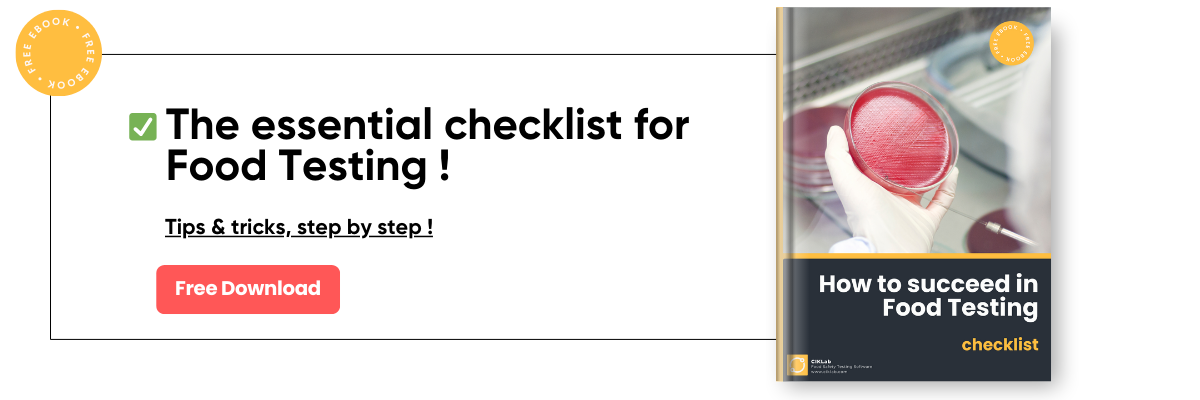Imagine a type of food contaminant that operates in the shadows, often unfamiliar to the general public, but remarkably efficient in its ability to compromise food safety: mycotoxins.
Summary :
1) Definition and origin of mycotoxins
2) What are the most common mycotoxins found in food ?
What techniques are used for mycotoxin analysis?
What standards exist for regulated toxins?
Which mycotoxins are easily quantifiable?
4) The challenge of sampling for mycotoxin analysis.analyse des mycotoxines
5) Serious incidents and notable cases attributed to mycotoxins
Definition and origin of mycotoxins
Although they don't make the "headlines" like other food hazards, they can affect a wide range of products, from grains to dairy items, as well as fruits and spices. According to some estimates, there are several hundred known mycotoxins (some suggest numbers exceeding 1,000).
Recent studies indicate that climate changes could increase the prevalence of mycotoxins in certain parts of the world. This might certainly necessitate a reevaluation of Quality Control plans.
What is a mycotoxin?
Mycotoxins are secondary metabolites (exotoxins) produced by certain molds, primarily by Aspergillus, Fusarium, and Penicillium. These substances can be extremely toxic (e.g., aflatoxins) to humans and animals when ingested, inhaled, or even in contact with the skin.
Mycotoxins can naturally occur in a wide range of plant-based products such as grains, nuts, spices, as well as fruits and vegetables. Contamination is linked to mold growth when favorable conditions are present (humidity, warmth, CO2). It occurs both during cultivation and in the storage of harvested crops or materials.
They can also enter the food chain by contaminating animal feed, posing an indirect risk to human food consumption as they can accumulate in animal-derived products like milk or meat. Unlike most bacteria, yeasts, and molds, mycotoxins are heat-stable; they withstand traditional cooking and sterilization methods quite well.
The effects on human and animal health are numerous:
They range from acute poisoning to long-term effects such as immunodeficiency and cancer. Certain mycotoxins like aflatoxin B1, for example, are classified as carcinogenic to humans, while others, such as aflatoxin M1, are classified as possible carcinogens. Others exhibit high toxicity to the liver (causing hepatitis and cirrhosis), kidneys, nervous system, immune system, or endocrine system.
In Europe, human exposure to high doses of mycotoxins is rare, but it should remain a significant concern in both human and animal nutrition, especially due to climate change (Caloni, F. (2022). Climate Change and Effects on Molds and Mycotoxins).
The most serious risk for humans arises from chronic and insidious dietary exposure to low levels of contamination.
What are the most common mycotoxins found in food ?
Among the most common mycotoxins, there are aflatoxins, produced by molds Aspergillus flavus and Aspergillus parasiticus. These toxins are often found in cereals such as maize and wheat, as well as in dried fruits and spices. Aflatoxin M1, a metabolite of aflatoxin B1, is frequently detected in milk and dairy products. Ochratoxin A is another prevalent mycotoxin, produced by several species of Aspergillus and Penicillium, and it's often found in cereals and coffee beans. Patulin is frequently found in apples and apple-derived products. Fumonisins and zearalenone are other common mycotoxins produced by Fusarium fungi and are often associated with various grains. Additionally, there are nivalenol and deoxynivalenol, also produced by Fusarium fungi, which are often linked to wheat and barley. T-2 and HT-2 toxins are trichothecenes produced by Fusarium and can be found in oats. Citrinin is another mycotoxin produced by Penicillium and is often found in stored grains and dairy products. Sterigmatocystin, produced by Aspergillus versicolor and other Aspergillus species, is commonly associated with grains and cereal products. Lastly, ergotamine, a mycotoxin produced by the fungus Claviceps purpurea, is often found in rye and other cereals.
Mycotoxins led to 485 notifications (+10%) in the European Union in 2022. This is the third most reported hazard in the Union, following pesticides and pathogens. Aflatoxins account for 85% of these cases.
Annual report Alert and Cooperation Network - 2023
What techniques are used for mycotoxin analysis?
There are numerous standardized methods for quantifying mycotoxins in various types of matrices, both in human and animal food. Many laboratories follow the available standards, and they also employ adapted and sometimes accredited in-house methods for specific matrices.
Other laboratories have developed and are now integrating multiple screening methods to detect and quantify a significant number of mycotoxins in a single run. This includes well-known, regulated mycotoxins as well as "emerging" mycotoxins, which are now detectable and quantifiable, even though regulatory thresholds might not yet exist.
Techniques like ELISA are inexpensive and rapid but less precise. They are sometimes suitable for routine use to provide initial assessments or screenings. Presently, the most commonly used techniques, often outsourced, primarily rely on high-performance chromatography such as GC-LC-Fluo, GC-LC-MS, or LC-MS/MS. These techniques offer high sensitivity and efficient compound separation.
What standards exist for regulated toxins?
Here are a few examples of standards used for the analysis of the most common and regulated mycotoxins (EC Regulation No. 915/2023).
| Mycotoxins |
Mold Producers | Affected Matrices | Examples of Standards |
|---|---|---|---|
| Aflatoxins | Aspergillus flavus, A. parasiticus | Cereal, nuts, derivative products | NF EN ISO 16050 |
| Ochratoxin A | Aspergillus ochraceus, Penicillium verrucosum | Food products, excluding infant and young child foods | NF EN 17279 |
| Zearalenon | Fusarium spp. | Food products, except for infant and young child foods | NF EN 17279 |
| Fumonisins | Fusarium verticillioides, F. proliferatum | Food products, excluding infant and young child foods | NF EN 17279 |
| Trichothecens A et B | Fusarium spp., Myrothecium, Trichoderma, Cephalosporium | Cereals and cereal products | NF EN 17280 |
| Patulin | Penicillium expansum | Apples, apple juice |
NF EN 14177 |
| Citrinin | Penicillium citrinum | Cereals, red yeast rice (RYR), herbs, dietary supplements | NF EN 17023 |
| Ergotamin | Claviceps purpurea | Cereals and cereal products | NF EN 17425 |
Which mycotoxins are easily quantifiable?
The mycotoxins below, although not all regulated, are nevertheless quantifiable in some specialized subcontracted laboratories, often in "multimethod" and in LC-MS/MS
| Group | Mycotoxins | Mold Producers |
| Aflatoxines | Aflatoxine B1, Aflatoxine B2, Aflatoxine G1, Aflatoxine G2, Aflatoxine M1 | Aspergillus |
| Alcaloïdes de l’ergot | Ergocornine, Ergocristine, Ergocryptine, Ergométrine, Ergosine, Ergotamine, etc. | Claviceps |
| Autres mycotoxines d'aspergillus et penicillium | Citrinine, Patuline, Acide cyclopiazonique, Stérigmatocystine, Roquefortine C | Aspergillus et Penicillium |
| Autres mycotoxines de fusarium | Moniliformine, Beauvericine | Fusarium |
| Enniatines | Enniatine A, Enniatin A1, Enniatine B, Enniatine B1 | - |
| Fumonisines | Fumonisine B1, Fumonisine B2, Fumonisine B3 | Fusarium |
| Ochratoxines | Ochratoxine A, Ochratoxine B, Ochratoxine alpha | Aspergillus et Penicillium |
| Toxines d’alternaria | Acide ténuazonique, Alternariol, Altenuene, Alternariol methyl ether, Tentoxin, Altertoxin I | Alternaria |
| Toxines trémorgènes | Verruculogen | Aspergillus et Penicillium |
| Trichothécènes type A | T-2 toxin, HT-2, T-2 tétraol, T-2 triol, DAS, MAS, Néosolaniol | Fusarium |
| Trichothécènes type B | DON, Deoxynivalenol-3-glucoside, DOM-1, Nivalénol, Fusarénone X, 15 ac DON, 3 ac DON | Fusarium |
| Zéaralénone et métabolites | Zéaralénone, Zéaralanol alpha, Zéaralanol béta, Zéaralénol alpha, Zéaralénol béta | Fusarium |
Regulation
In the European Union, limits for mycotoxins in human food are set by Regulation (EC) No. 915/2023. This regulation applies to a wide variety of products, and the permitted maximum levels can vary significantly depending on the matrices. Mycotoxins are subject to ongoing evaluations by the European Food Safety Authority (EFSA) concerning toxicological thresholds, population exposure, and the ability to quantify new mycotoxins (emerging ones).
The following mycotoxins are regulated for human consumption under (EC) Regulation No. 915/2023.
- Aflatoxins
- Ochratoxin A
- Patulin
- Citrinin
- Deoxynivalenol
- Zearalenone
- Fumonisins
- Ergot sclerotia and ergot alkaloids
Emerging mycotoxins
Several so-called "emerging" mycotoxins are under the surveillance and monitoring of EFSA. Some, like Alternaria toxins, are subject to recommendations but are not yet formally "regulated."
- Beauvericin
- Alternaria Toxins ("alternariol monomethyl ether" and "tephropyrone") - Recommendation (EU) 2022/553
- Enniatins (A, A1, B, and B1)
- Sterigmatocystin
- Moniliformin
- Diacetoxyscirpenol
- Apicidin
- Aurofusarin
- And others
The challenge of sampling for mycotoxin analysis.
The sampling of agri-food products to detect the presence of mycotoxins is in itself a challenge due to the heterogeneous distribution of mycotoxins. To ensure accurate and reliable assessment, it is essential to follow appropriate sampling protocols. Here are some guidelines to consider:
For Human Food: Regulation (EC) No 401/2006 lays down the sampling methods and analysis methods for the official control of the levels of mycotoxins in foodstuffs.
For Animal Feed: Regulation (EC) No 152/2009 lays down the sampling and analysis methods for the official control of feed.
The standard NF EN ISO 24333:2009 on sampling cereals can be a valuable guide for professionals in the food industry. This standard provides specific recommendations on sampling methods for cereals, which are often most susceptible to mycotoxin contamination.
Multiple Sampling: It is highly recommended to take multiple samples from different parts of the lot. This accounts for the variability in mycotoxin distribution within the agri-food product. By sampling from different locations, you increase the chances of detecting mycotoxin presence even if they are unevenly distributed within the lot.
Adequate Volume: For cereal samples, for example, it's advised to collect a sample volume of at least 1 kg. This amount is considered suitable to obtain accurate analysis results.
Accurate assessment of mycotoxin contamination is essential to ensure food safety. By adhering to these rigorous sampling protocols, professionals in the food industry can enhance the accuracy of their mycotoxin analyses.
Serious incidents and notable cases attributed to mycotoxins
Aflatoxicosis Outbreak in Kenya (2004): Over 100 people died and hundreds more were hospitalized after consuming maize contaminated with aflatoxins. Reference: "Outbreak of an acute aflatoxicosis in Kenya in 2004: identification of the causal agent" (Applied and Environmental Microbiology, 2005).
Aflatoxicosis in Kenya (2010): An aflatoxicosis outbreak was reported in Kenya, affecting multiple individuals and leading to hospitalizations. The contamination was caused by the consumption of maize contaminated with aflatoxins. Reference: "Aflatoxin Contamination of Commercial Maize Products during an Outbreak of Acute Aflatoxicosis in Eastern and Central Kenya" (Environmental Health Perspectives, 2010).
Citrinin Outbreak in China (1972): Hundreds of people were affected by the consumption of rice contaminated with citrinin, a mycotoxin produced by Penicillium molds. Reference: "Mycotoxins in Asia: A Historical Review" (Food Safety, 2017).
Milk Contamination in China (2012): Traces of aflatoxin M1 were found in samples of milk sold in China, leading to a massive recall of dairy products. Media Reports and Press Releases, 2012.






